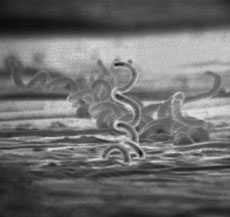Syphilis Information
 Syphilis is a complex, sexually transmitted disease (STD) with a highly variable clinical course. The disease is caused by the bacterium, Treponema pallidum. In the United States, 63,450 cases of syphilis, including 458 cases of congenital syphilis, were detected by public health officials in 2014. The South has the highest rate of syphilis in the U.S. (23.8 cases per 100,000 population) followed by the West (21.9), Northeast (19.8), and Midwest (11.8).
Syphilis is a complex, sexually transmitted disease (STD) with a highly variable clinical course. The disease is caused by the bacterium, Treponema pallidum. In the United States, 63,450 cases of syphilis, including 458 cases of congenital syphilis, were detected by public health officials in 2014. The South has the highest rate of syphilis in the U.S. (23.8 cases per 100,000 population) followed by the West (21.9), Northeast (19.8), and Midwest (11.8).
Syphilis is passed from person-to-person through direct contact with a syphilis sore (called a chancre). Chancres mainly occur on the external genitals, vagina, anus, or rectum, but may also occur on the lips and in the mouth. Transmission of syphilis occurs during vaginal, anal, or oral sex. Pregnant women with the disease can pass it on to their babies.
Syphilis cannot be spread by toilet seats, door knobs, swimming pools, hot tubs, bath tubs, shared clothing, or eating utensils.
The first symptoms of syphilis can appear from 10-90 days (average 21 days). The first stage is marked by the appearance of a chancre that is usually firm, round, small, and painless. The chancre lasts 1-5 weeks and heals on its own. The second stage of syphilis begins when one or more areas of the skin develops a non-itching rash. Rashes can appear as rough, “copper penny” spots on the palms of the hands and bottom of the feet; a prickly heat rash, small blotches or scales all over the body; a bad case of old acne; moist warts in the groin area; white patches in the mouth; sunken dark circles the size of a nickel or dime; or as pus-filled eruptions like chicken pox. Rashes can last 2-6 weeks and, like the chancre, heal on their own. During the first and second stages of syphilis, an infected person can easily pass the disease to their sex partners.
The latent (hidden) stage of syphilis begins when the secondary symptoms disappear. If the infected person has not received treatment, he/she still has syphilis even though there are no symptoms. Syphilis remains in the body and begins to damage the internal organs including the brain, nerves, eyes, heart, blood vessels, liver, bones, and joints.
Congenital syphilis is a disease that occurs when a mother with syphilis passes the infection on to her baby during pregnancy. Up to 40% of babies born to women with untreated syphilis may be stillborn, or die from the infection as a newborn. Babies born with congenital syphilis can have deformed bones, severe anemia (low blood count), enlarged liver and spleen, jaundice (yellowing of the skin or eyes), nerve problems such as blindness or deafness, or meningitis, which can cause developmental delays, seizures and failure to thrive. Treating pregnant women at least 30 days before delivery is 98% effective at preventing illness in infants.
Bicillin, a type of penicillin (G benzathine), will cure a person who has had syphilis for <1 year. More doses are needed to cure someone who has had it longer. A baby born with the disease needs daily penicillin treatment for 10 days. There are no home remedies or over-the-counter drugs that cure syphilis. Washing the genitals, urinating, or douching after sex does not prevent syphilis. Any unusual discharge, sore, or rash -especially in the groin area – should be a signal to stop having sex and to see a doctor immediately.
For further information on syphilis, visit the CDC Division of STD Prevention or call CDC-INFO at 1-800-CDC-INFO (800-232-4636)
Facts & Information about Syphilis
- Page last reviewed: December 14, 2015
- Page last updated: December 14, 2015
- Content Source:


 ShareCompartir
ShareCompartir